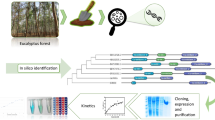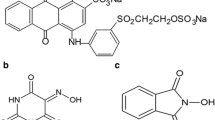Abstract
The supernatant obtained from the extracellular laccase produced by Phanerochaete chrysosporium was used as the enzyme source to conduct a partial purification, characterization and dye decolorization study. The partially purified enzyme was stable in the pH range of 3–5 and showed an optimum activity at pH 4.0, using guaiacol as a substrate. Laccase stability of pH was determined and discovered to retain 100% of its activity at a pH of 4.0 after 2 h. The maximum enzyme activity was obtained between 30 and 50 °C. The maximum velocity and Michaelis constant were calculated as 3.171 µM−1·min and 1628.23 µM, respectively. The enzyme was activated by Fe2+, Zn2+, Ca2+ and Cu2+, while Hg2+, Mn2+, Co2+, Mg2+, Cd2+, Ni2+ reduced the laccase activity. The partially purified enzyme was strongly inhibited by 1 mM of NaN3 and sodium thioglycolate. Among the eight different dyes (Malachite green, Safranin, Crystal violet, Methylene blue, Eriochrome black T, Methyl red, Methyl orange, Rhodamine B and Nigrosin), the enzyme showed highly efficient decolorizing activity (99%) toward Malachite green after treatment for 24 h at 30 °C. Antibacterial results showed that the product obtained by treating the dye with the enzyme is completely non-toxic to Staphylococcus aureus, Pseudomonas aeruginosa and Escherichia coli. High-performance liquid chromatography and mass spectroscopy analysis of the extracted product confirmed the complete biodegradation of Malachite green and Leucomalachite green. Di-benzyl methane and 4-(dimethylamino) benzaldehyde were the ultimate products identified in this research.







Similar content being viewed by others
References
Afreen S, Shamsi TN, Baig MA et al (2017) A novel multicopper oxidase (laccase) from cyanobacteria: purification, characterization with potential in the decolorization of anthraquinonic dye. PLoS ONE 12:e0175144
Asgher M, Iqbal HMN, Asad MJ (2012) Kinetic characterization of purified laccase produced from Trametes versicolor IBL-04 in solid state bio-processing of corncobs. BioResources 7:1171–1188
Attéké C, Mounguengui S, Tchinda J-BS et al (2013) Biodegradation of reactive blue 4 and orange G by Pycnoporus sanguineus strain isolated in Gabon. J Bioremediat Biodegrad 4:1000206
Barapatre A, Aadil KR, Jha H (2017) Biodegradation of malachite green by the ligninolytic fungus Aspergillus flavus. CLEAN Soil Air Water 45:1600045
Baumer JD, Valério A, de Souza SMGU et al (2018) Toxicity of enzymatically decolored textile dyes solution by horseradish peroxidase. J Hazard Mater 360:82–88
Chakroun H, Mechichi T, Martinez MJ et al (2010) Purification and characterization of a novel laccase from the ascomycete Trichoderma atroviride: application on bioremediation of phenolic compounds. Process Biochem 45:507–513
Cockerill FR (2011) Performance standards for antimicrobial susceptibility testing: twenty-first informational supplement. Clinical and Laboratory Standards Institute (CLSI)
Couto SR, Herrera JLT (2006) Industrial and biotechnological applications of laccases: a review. Biotechnol Adv 24:500–513
Crini G, Badot P-M (2008) Application of chitosan, a natural aminopolysaccharide, for dye removal from aqueous solutions by adsorption processes using batch studies: a review of recent literature. Prog Polym Sci 33:399–447
Cristóvão RO, Tavares APM, Ferreira LA et al (2009) Modeling the discoloration of a mixture of reactive textile dyes by commercial laccase. Bioresour Technol 100:1094–1099
Desai SS, Tennali GB, Channur N et al (2011) Isolation of laccase producing fungi and partial characterization of laccase. Biotechnol Bioinform Bioeng 1:543–549
Du L-N, Wang S, Li G et al (2011) Biodegradation of malachite green by Pseudomonas sp. strain DY1 under aerobic condition: characteristics, degradation products, enzyme analysis and phytotoxicity. Ecotoxicology 20:438–446
D’Souza DT, Tiwari R, Sah AK, Raghukumar C (2006) Enhanced production of laccase by a marine fungus during treatment of colored effluents and synthetic dyes. Enzym Microb Technol 38:504–511
Ghobadi Nejad Z, Yaghmaei S, Hosseini RH (2009) Production of extracellular protease and determination of optimal condition by Bacillus licheniformis bbrc 100053 (research note). Int J Eng B Appl 22:221
Ghobadi Nejad Z, Borghei M, Yaghmaei S (2018a) Effect of polyethylene glycol and triton X-100 on the enzymatic treatment of bisphenol A. Int J Eng Trans B Appl 31:1816–1823
Ghobadi Nejad Z, Borghei SM, Yaghmaei S (2018b) Kinetic studies of Bisphenol A in aqueous solutions by enzymatic treatment. Int J Environ Sci Technol. https://doi.org/10.1007/s13762-018-1654-6.
Gomori G (1955) [16] Preparation of buffers for use in enzyme studies. Methods Enzymol 1:138–146
Grassi E, Scodeller P, Filiel N et al (2011) Potential of Trametes trogii culture fluids and its purified laccase for the decolorization of different types of recalcitrant dyes without the addition of redox mediators. Int Biodeterior Biodegrad 65:635–643
Hadibarata T, Syafiuddin A, Al-Dhabaan FA, Elshikh MS (2018) Biodegradation of Mordant orange-1 using newly isolated strain Trichoderma harzianum RY44 and its metabolite appraisal. Bioprocess Biosyst Eng 41(5):621–632
Jain K, Shah V, Chapla D, Madamwar D (2012) Decolorization and degradation of azo dye–Reactive Violet 5R by an acclimatized indigenous bacterial mixed cultures-SB4 isolated from anthropogenic dye contaminated soil. J Hazard Mater 213:378–386
Jeon SJ, Lim SJ (2017) Purification and characterization of the laccase involved in dye-decolorization by the white rot fungus Marasmius scorodonius. J Microbiol Biotechnol 27:1120–1127
Jeon JR, Baldrian P, Murugesan K, Chang Ys (2012) Laccase-catalysed oxidations of naturally occurring phenols: from in vivo biosynthetic pathways to green synthetic applications. Microb Biotechnol 5:318–332
Jiang M, Ten Z, Ding S (2013) Decolorization of synthetic dyes by crude and purified laccases from Coprinus comatus grown under different cultures: the role of major isoenzyme in dyes decolorization. Appl Biochem Biotechnol 169:660–672
Jin X, Ning Y (2013) Laccase production optimization by response surface methodology with Aspergillus fumigatus AF1 in unique inexpensive medium and decolorization of different dyes with the crude enzyme or fungal pellets. J Hazard Mater 262:870–877
Juárez-Gómez J, Rosas-Tate ES, Roa-Morales G et al (2018) Laccase inhibition by mercury: kinetics, inhibition mechanism, and preliminary application in the spectrophotometric quantification of mercury ions. J Chem 2018:7462697. https://doi.org/10.1155/2018/7462697
Kumar R, Ahmad R (2011) Biosorption of hazardous crystal violet dye from aqueous solution onto treated ginger waste (TGW). Desalination 265:112–118
Lam YW, Wang HX, Ng TB (2000) A robust cysteine-deficient chitinase-like antifungal protein from inner shoots of the edible chive Allium tuberosum. Biochem Biophys Res Commun 279:74–80
Lin J, Zhang X, Li Z, Lei L (2010) Biodegradation of Reactive blue 13 in a two-stage anaerobic/aerobic fluidized beds system with a Pseudomonas sp. isolate. Bioresour Technol 101:34–40
Liu L, Lin Z, Zheng T et al (2009) Fermentation optimization and characterization of the laccase from Pleurotus ostreatus strain 10969. Enzym Microb Technol 44:426–433
Lomascolo A, Record E, Herpoël-Gimbert I et al (2003) Overproduction of laccase by a monokaryotic strain of Pycnoporus cinnabarinus using ethanol as inducer. J Appl Microbiol 94:618–624
Lowry OH, Rosebrough NJ, Farr AL, Randall RJ (1951) Protein measurement with the Folin phenol reagent. J Biol Chem 193:265–275
Lu L, Zhao M, Zhang B-B et al (2007) Purification and characterization of laccase from Pycnoporus sanguineus and decolorization of an anthraquinone dye by the enzyme. Appl Microbiol Biotechnol 74:1232–1239
Maalej-Kammoun M, Zouari-Mechichi H, Belbahri L et al (2009) Malachite green decolourization and detoxification by the laccase from a newly isolated strain of Trametes sp. Int Biodeterior Biodegrad 63:600–606
Mathur G, Nigam R, Jaiswal A, Kumar C (2013) Bioprocess parameter optimization for laccase production in solid state fermentation. J Biotechnol Bioeng Res 4:521–530
Méndez-Hernández JE, Ramírez-Vives F, Solís-Oba M et al (2013) Detoxification and mineralization of Acid Blue 74: study of an alternative secondary treatment to improve the enzymatic decolourization. World J Microbiol Biotechnol 29:805–814
Mukherjee T, Das M (2014) Degradation of malachite green by enterobacter asburiae strain XJUHX-4TM. CLEAN Soil Air Water 42:849–856
Nagai M, Sato T, Watanabe H et al (2002) Purification and characterization of an extracellular laccase from the edible mushroom Lentinula edodes, and decolorization of chemically different dyes. Appl Microbiol Biotechnol 60:327–335
Niladevi KN, Jacob N, Prema P (2008) Evidence for a halotolerant-alkaline laccase in Streptomyces psammoticus: purification and characterization. Process Biochem 43:654–660
Pandey A, Singh P, Iyengar L (2007) Bacterial decolorization and degradation of azo dyes. Int Biodeterior Biodegrad 59:73–84
Patel H, Gupte A, Gupte S (2009) Effect of different culture conditions and inducers on production of laccase by a basidiomycete fungal isolate Pleurotus ostreatus HP-1 under solid state fermentation. BioResources 4:268–284
Pearce CI, Lloyd JR, Guthrie JT (2003) The removal of colour from textile wastewater using whole bacterial cells: a review. Dye Pigment 58:179–196
Revankar MS, Lele SS (2007) Synthetic dye decolorization by white rot fungus, Ganoderma sp. WR-1. Bioresour Technol 98:775–780
Sadhasivam S, Savitha S, Swaminathan K, Lin F-H (2008) Production, purification and characterization of mid-redox potential laccase from a newly isolated Trichoderma harzianum WL1. Process Biochem 43:736–742
Shanmugam S, Ulaganathan P, Swaminathan K et al (2017) Enhanced biodegradation and detoxification of malachite green by Trichoderma asperellum laccase: degradation pathway and product analysis. Int Biodeterior Biodegrad 125:258–268
Stoilova I, Krastanov A, Stanchev V (2010) Properties of crude laccase from Trametes versicolor produced by solid-substrate fermentation. Adv Biosci Biotechnol 1:208–215
Taguchi T, Ebihara K, Yanagisaki C et al (2018) Decolorization of recalcitrant dyes by a multicopper oxidase produced by Iodidimonas sp. Q-1 with iodide as a novel inorganic natural redox mediator. Sci Rep 8:6717. https://doi.org/10.1038/s41598-018-25043-1
Wu Y-R, Luo Z-H, Chow RK-K, Vrijmoed LLP (2010) Purification and characterization of an extracellular laccase from the anthracene-degrading fungus Fusarium solani MAS2. Bioresour Technol 101:9772–9777
Yang XQ, Zhao XX, Liu CY et al (2009) Decolorization of azo, triphenylmethane and anthraquinone dyes by a newly isolated Trametes sp. SQ01 and its laccase. Process Biochem 44:1185–1189
Yesilada O, Birhanli E, Geckil H (2018) Bioremediation and decolorization of textile dyes by white rot fungi and laccase enzymes. In: Prasad R (ed) Mycoremediation and environmental sustainability. Springer, Cham, pp 121–153
Yuan X, Tian G, Zhao Y et al (2016) Degradation of dyes using crude extract and a thermostable and pH-stable laccase isolated from Pleurotus nebrodensis. Biosci Rep 36:e00365
Acknowledgements
This work was supported by the Biotechnology Development Council of the Islamic Republic of Iran (Grant No: 960402). This research was also supported by the Iran National Science Foundation (INSF) (Grant No: 95833882). The authors would like to acknowledge Biochemical and Bioenvironmental Research Center, Sharif University of Technology, for providing valuable help to accomplish the research work. They also thank the Graduate School of the Environment and Energy, Science and Research Branch, Islamic Azad University.
Author information
Authors and Affiliations
Corresponding author
Ethics declarations
Conflict of interest
The authors have no financial conflicts of interest to declare.
Additional information
Editorial responsibility: M. Abbaspour.
Electronic supplementary material
Below is the link to the electronic supplementary material.
Rights and permissions
About this article
Cite this article
Ghobadi Nejad, Z., Borghei, S.M. & Yaghmaei, S. Biodegradation of synthetic dye using partially purified and characterized laccase and its proposed mechanism. Int. J. Environ. Sci. Technol. 16, 7805–7816 (2019). https://doi.org/10.1007/s13762-019-02226-5
Received:
Revised:
Accepted:
Published:
Issue Date:
DOI: https://doi.org/10.1007/s13762-019-02226-5




